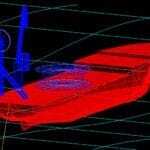Passing Ship Effects
STA uses PASS-MOOR and OrcaFlex for the dynamic mooring analysis of ships moored at piers and wharfs.
STA designed and analysed a mooring system for a 90,000 ton dwt coal carrier, moored at a new wharf in the St. John’s River, Jacksonville, FL, for Keystone Coal, 2009. Dynamic simulations of motions induced by ships of up to 200,000 ton dwt, passing close to the coal carrier, were performed using PASS-MOOR and OrcaFlex, enabling evaluation of dynamic mooring tensions.
The objective of the work was two-fold:
- to assess the reduction in risk of the coal carrier breaking away from its moorings (as a consequence of the loads caused by a passing vessel) that may be achieved by increasing the setback of the new wharf from the edge of the navigable channel, and
- to identify through numerical study the characteristics of an acceptable mooring and fendering system to respond to the predicted forces caused by the passing ship resulting in surge, sway and yaw motions.
The minimum SF against line breakage for the mooring system designed by STA is in excess of 4.0 for a large passing ship travelling at 7 knots, with the minimum possible separation (315 feet) from the moored coal carrier, at its deepest possible draft. Increasing the setback would have negligible effect on the probability of failure in this scenario. In this case the probability of failure is estimated to be less than 2 x 10-5, putting the risk category roughly equal to that of dam designs where a failure would cause serious loss of life.
For a ship travelling at an imprudent velocity of 9 knots, the minimum SF is around 2.1 at the minimum possible separation distance and well in excess of 3 at the most likely passing distance. For the minimum distance scenario and a 9 knot passing velocity increasing the setback would result in a measurable risk reduction, although with an SF greater than 2 the scenario has acceptable risk. For the most likely passing distance and a 9 knot passing velocity increasing the setback would have a very slight impact on risk reduction, but the risk is already very low and quite acceptable.
The STA final report became public domain and was presented to the US Army Corps of Engineers. The main conclusion was that with the present setback (in 2009) the risks were well within acceptable values and further cutback would not substantially change them.






